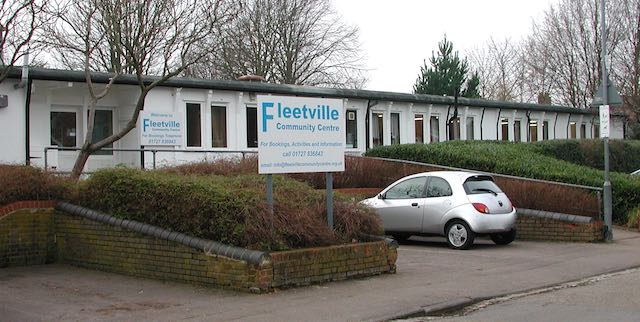Not only were there no houses on what later became the recreation ground, but there were few homes built on the T E Smith land between Royal Road and Tess Road (now Woodstock Road south) either. A row of six small homes appeared in Royal Road, and one detached and two adjacent semi-detached houses on the west side of Tess Road.
 |
| 1922 OS map showing the school and (circled in blue) the police station and police houses. |
 |
| 1922 OS map showing the Hatfield Road block outlined in red. MAPS ABOVE COURTESY NATIONAL LIBRARY OF SCOTLAND |
This was the point, in 1906, when the County authority concluded it needed to take decisive action in providing services for this extensive series of private residential estates, and with more to come; open spaces, education facilities and the Police Constabulary were definitely not part of the brief of house builders. The County moved its police station into the first house in Tess Road with the Sergeant and Constable living next door. In the 1970s all three buildings were demolished to provide land for parking and a children's nursery. The largest land acquisition came to provide – at last – land for an elementary school; this came following pressure from countless parents who had to send their children "over to the Camp School".
 |
| Royal Road to the left; Woodstock Road (Tess Road) to the right. The little car park and the building beyond are the site of the former police station and police houses. |
 |
| Fleet House to the left and the parade beyond in 1964. COURTESY ST ALBANS MUSEUMS |
 |
| Post-conversion view of Fleet House with added access to ground floor flat. |
However, Dr Smythe was beaten into second place by the arrival of John Smith, stationer and draper who previously ran the third shop in Bycullah Terrace, which also had a corner devoted to a Post Office. It had been a busy shop and Mr Smith sought more space for his trading. Purchasing the corner plot at Tess Road he engaged the building partnership of Goodwin & Hart to create what everyone still knows as the Fleetville Post Office. The original garden plot faced Hatfield Road, but an extension to the Post Office and drapery was constructed on the garden c1960. This is now the separate business of MediVet.
 |
| The Post Office still with its rear garden and name fascia A Rankin Smith in 1964. COURTESY ST ALBANS MUSEUMS |
 |
| The shops c1960. The extension being constructed in the garden of The Post Office. COURTESY JACKIE ALDRIDGE |
The trend in the 1930s for a single building combining several shops, and also identified in a recent post, was continued here where three standard width units and a pair of half-sized units were built. First to open was Percy Hall's hairdresser departments for both women and men. Mr Hall had previously opened his first salon nearby in Bycullah Terrace and had others around Fleetville at different times.
 |
| Recent view of the shop which began as Harpers Motors and later St Albans' Scooters. |
When Norman Harper first opened his Motor Sales showroom as late as 1939 the legal documents reveal this block of land had still been in the ownership of the estate of Thomas E Smith from the former printing works opposite. Although now a phone repair shop the street elevation still has the original bracket arm for frontage lighting; street lighting in the 1930s was still quite poor.
The two half shops began as London Central Meats and a studio photographer. After the Second War they were Baxter's Butchers and Garrard Fruiterers; and along the sideway to the right was a signwriter's business for S T Broad.
So, where do the flicks come in? Well, the building came – and went – so quickly that not a single performance took place. Russell Edwards living in Granville Road claimed to be a showman, and saw a business opportunity which wasn't entirely legal and put up a secondhand tin building as a picture house/cinema. Without using his own funds this serial mischief maker assured an investor that the cinema was already open and operating profitably and attracting patrons in numbers which, in fact, could not possibly have been accommodated. In fact it was just a pile of tin and iron lying on the ground and the men engaged to erect it were sometimes not paid. Creditors caused Edwards to be taken to court – again, and the court ordered that the building, so close to opening, should be taken apart and sold to defray court costs. When did this occur? In 1912, so becoming the first occupier of this block. And where was it? It all happened on the plot which is still Fleetville Post Office today.
Sorry you missed the show!
Next time we'll trace the story of the most well known Hatfield Road trading quarter, Bycullah Terrace, and discover the origin of its name.


















